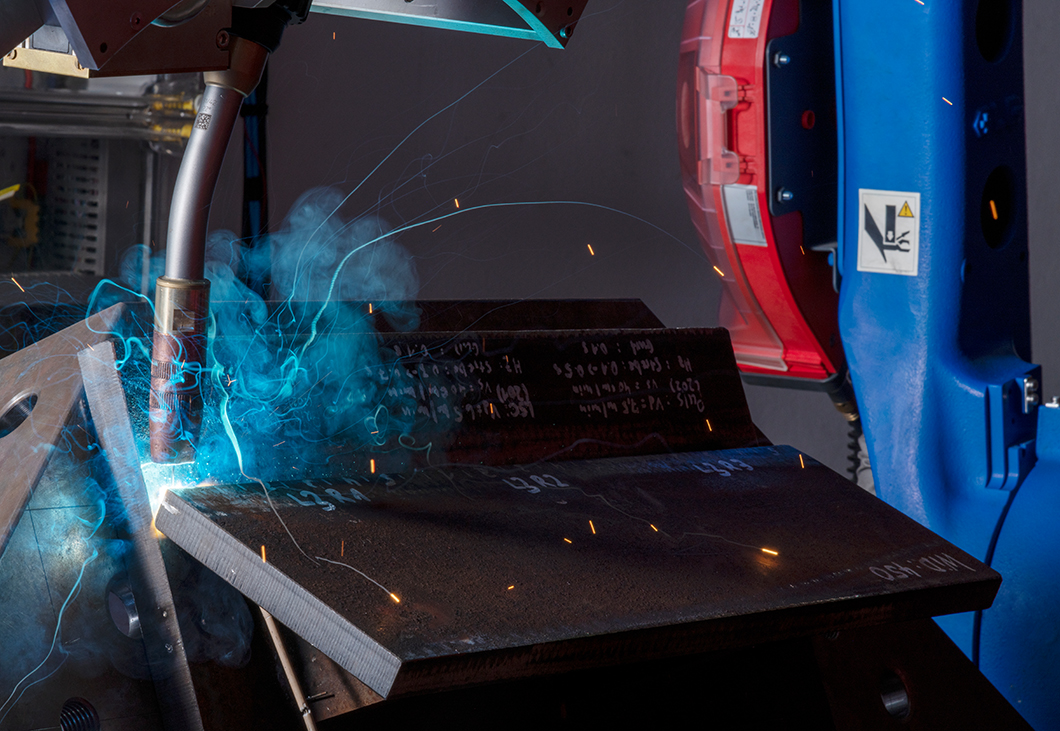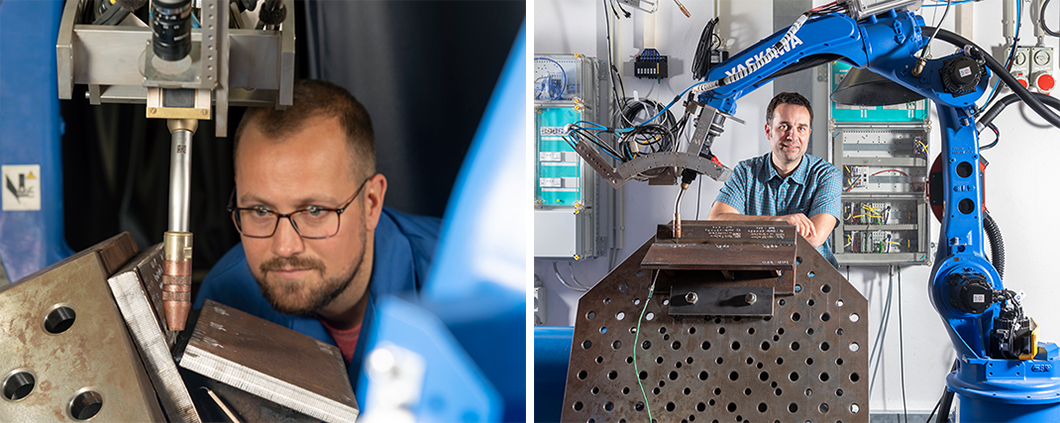
BAM experts want to use smart welding techniques to reduce CO2 emissions in the construction of wind turbines: a robot welds together two pieces of steel.
Source: BAM
The rapid expansion of offshore wind energy is important if Germany and the EU want to reach their climate targets. Many tonnes of CO₂ can also be saved during the construction of the turbines. Andreas Pittner aims to combine lightweight construction principles with digitalised quality control.
Offshore wind turbines are built on a massive support structure up to 60 metres high. Most of it is hidden below the waterline. A single steel pile is usually used for the mighty construction: a so-called monopile. It is easy to install but consumes a lot of resources. This is because up to 2,000 tonnes of steel are welded together for a single pile, which releases large quantities of CO₂.
The amount of CO₂ released is significantly lower if filigree support structures are used instead of monopiles. These lightweight structures are called jacket foundations. They need a lot less steel. However, welding them together still poses a technical challenge, which is why the industry has not yet taken advantage of these major CO₂ savings.
Savings potential of 100,000 tonnes of CO₂
This is mainly due to the very complex weld seams: Today, jacket foundations are usually welded together manually from individual steel pipes and then transported to their place of use by special ships. Tolerances in manual production and high safety requirements necessitate a conservative design of the components. This means that currently very thick-walled steel pipes are still processed, which must withstand the enormous forces of wind and waves on the high seas.
“The strength of the jackets could be increased through automated welding processes which at the same time strengthen the weld seams. As a result, one could use pipes with smaller wall thicknesses and thus reduce the amount of steel,” explains Andreas Pittner. “The potentials are impressive.” Compared to a monopile, a lightweight design could save 20 percent of the mass, i.e. about 400 tonnes of steel and thus around 800 tonnes of CO₂. If the design of the weld seams is further optimised and energy-saving welding techniques are used, CO₂ emissions could be reduced further. In total, the construction of a wind farm with 100 turbines can result in a reduction of over 100,000 tonnes of CO₂.
The goal: Rapid technology transfer to industry
However, the very complex weld seams of the jackets still pose a challenge for automated production and therefore hinder an economical application of lightweight construction principles in steel construction.
"Through automated welding processes the amount of steel needed for offshore wind turbines can be reduced. The potential is impressive."
The joint project SmartWeld, led by Andreas Pittner, is looking for a solution to these issues. “We want to enable the use of lightweight construction technologies through the end-to-end digitalisation of the entire manufacturing and testing chain,” says the scientist. “This primarily concerns the monitoring of the seams during the welding process, but it is also relevant for the design of the equipment, component testing and quality management. We are deliberately working under real-life conditions so that the technology transfer to industry can succeed quickly.”

The robot produces more precise weld seams than a human could. This enables savings in steel – and thus in CO² . René Winterkorn (left) Andreas Pittner (right) at the welding robot
Source: BAM
SmartWeld is funded by the Federal Ministry for Economic Affairs and Climate Action as part of the Technology Transfer Programme Lightweight Construction with 3.17 million euros and is scheduled to run for three years. In addition to BAM, the Institute of Steel Construction and the Test Centre Support Structures of Leibniz Universität Hannover, the Fraunhofer Institute for Wind Energy Systems (IWES), Salzgitter Mannesmann Forschung GmbH and the engineering firm Jörss - Blunck - Ordemann GmbH are involved.
The support structures of wind turbines are ultimately just one example of the CO₂ savings potential through lightweight construction. The findings of SmartWeld could later be transferred to other areas in which large-format steel structures are manufactured, such as support structures for bridges.


